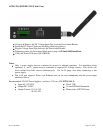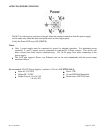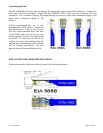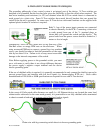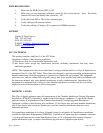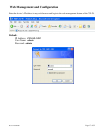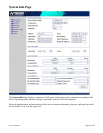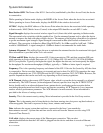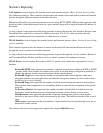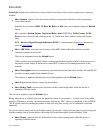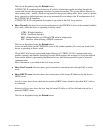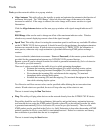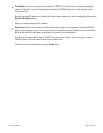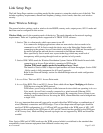Revision 04062009 Page 20 of 52
System Information
Base Station SSID: The Name of the 802.11 Service Set (established by the Host Access Point) the device
is connected to:
While operating in Station mode, displays the BSSID of the Access Point where the device has associated.
While operating in Access Point mode, displays the BSSID of the wireless device itself.
AP MAC: displays the MAC address of the Access Point where the device has associated while operating
in Station mode. MAC (Media Access Control) is the unique HW identifier on each 802.11 radio.
Signal Strength: displays the received wireless signal level (client-side) while operating in Station mode.
The represented value coincides with the graphical bar. Use the antenna alignment tool to adjust the device
antenna to improve the link with other wireless devices. The antenna of the wireless client has to be adjusted
to get the maximum signal strength. Signal Strength is measured in dBm (the Decibels referenced to 1
milliwatt). The conversion is defined as dBm=10log10(P/1mW). So, 0dBm would be 1mW and –72dBm
would be .0000006mW. A signal strength of –85dBm or better is recommended for stable links.
Antenna Alignment: This utility allows the user to optimize the antenna direction for maximum link signal.
More information is provided in the Tools sub-section.
TX Rate and RX Rate: displays the current 802.11 data transmission (TX) and data reception (RX) rate
while operating in Station mode. Data rates at 1,2,5.5,11Mbps (802.11b) and 6,9,12,18,24,36,48,54Mbps
(802.11) are possible. Typically, the higher the signal, the higher the data rate, and consequently the higher
the throughput. For maximum throughput (54Mbps), typically a –70dBm or better signal is required.
Frequency: This is the operating frequency and channel of the 802.11 Service Set (hosted by AP) the client
is connected to. Device uses this frequency to transmit and receive data. For 802.11Na operation, the range
of available frequencies are 5.745-5.825Ghz and for 802.11b/g/n operation, 2412-2472 MHz. However, the
specific frequencies that can be used will vary depending on local country regulations.
ACK Timeout: displays the current ACK Timeout value, which is set on the device manually or adjusted
automatically. The ACK Timeout (Acknowledgment Timeout) specifies how long the N-TRON 702-W
device should wait for an acknowledgment from a partner device confirming packet reception before
concluding the packet must have been in error and requires resending. ACK Timeout is a very important
outdoor wireless performance parameter. The ACK timeout is in microseconds. More information is
provided in the Advanced settings section.
Security: This is the current security setting. More information is provided in the Link Setup section.
Uptime: This is the running total of time the device has been running since last power up (hard-reboot) or
software upgrade. The time is expressed in days, hours, minutes and seconds.
Date: indicates the current system date and time, expressed in the form “year-month-day
hours:minutes:seconds”. System date and time can be retrieved from the Internet services using NTP
(Network Time Protocol).
LAN cable: displays the current status of the Ethernet port connection. This can alert
operator/user/technician that the LAN cable is plugged into the device and there is an active Ethernet
connection.



